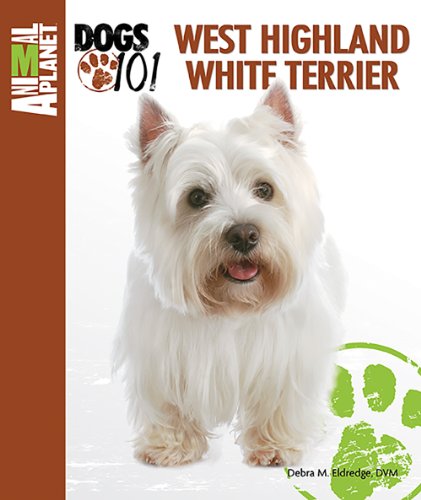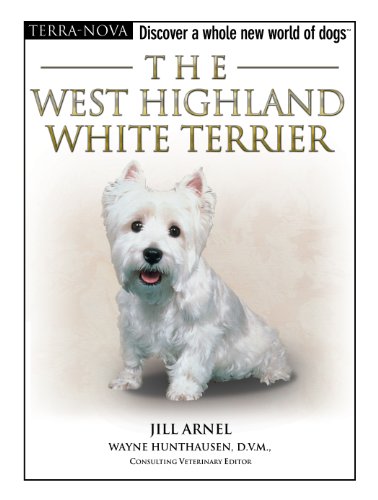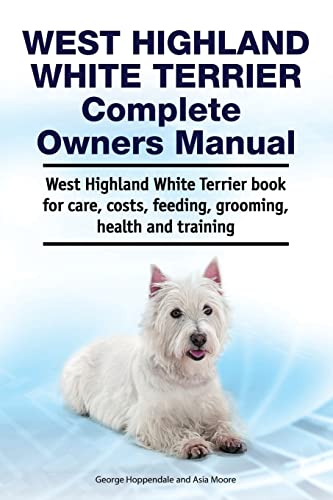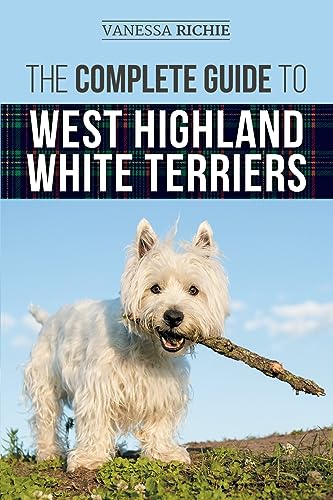All About West Highland White Terriers (Westies)
 Welcome to the comprehensive guide on the West Highland White Terriers, affectionately known as Westies, where the charm and vivacity of this small but sturdy breed are brought to light. From the rolling hills of Scotland, where they were originally bred for hunting and rodent control, these bright-white, confident canines have bounded into the hearts of dog lovers worldwide.
Welcome to the comprehensive guide on the West Highland White Terriers, affectionately known as Westies, where the charm and vivacity of this small but sturdy breed are brought to light. From the rolling hills of Scotland, where they were originally bred for hunting and rodent control, these bright-white, confident canines have bounded into the hearts of dog lovers worldwide.
- West Highland White Terriers
- All About West Highland White Terriers (Westies)
- West Highland White Terrier Dog Breed Information Guide
- West Highland White Terrier History
- West Highland White Terrier Appearance
- West Highland White Terrier Personality, Temperament & Behavior
- West Highland White Terrier Exercise Requirements
- West Highland White Terrier Grooming Needs
- West Highland White Terrier Training Tips
- West Highland White Terrier Health Concerns
- Is a Westie the Right Breed of Dog For You?
- Frequently Asked Questions About Westies
- 1. What is the origin of Westies?
- 2. How big do Westies get?
- 3. What is the typical temperament of a Westie?
- 4. Are Westies good with children and other pets?
- 5. How much grooming does a Westie require?
- 6. How often should I exercise my Westie?
- 7. What are common health issues in Westies?
- 8. What is the life expectancy of a Westie?
- 9. Are Westies easy to train?
- 10. What kind of diet is best for a Westie?
- 11. Do Westies bark a lot?
- 12. Are Westies suitable for apartment living?
- 13. How do I find a reputable Westie breeder?
- 14. Can Westies be left alone for long periods?
- 15. What activities do Westies enjoy?
- 16. Are Westies Hypoallergenic?
- 17. Are Westies Non-Shedding?
- Further Reading about the West Highland White Terrier Dog Breed
- Westie Books
Within these pages, you’ll embark on a historical journey, tracing the Westie’s lineage back to their roots, uncovering the evolution of this breed’s distinct appearance and spirited temperament.
Dive into the world of Westies, and you’ll discover a wealth of information about their endearing qualities, alongside practical advice for their care. Each Westie is a bundle of energy, boasting a lifespan of roughly 12 to 16 years, and comes with a unique set of needs in terms of health, nutrition, and grooming.
This guide is packed with insights into common health concerns specific to the breed, as well as tips on how to maintain their iconic, plush white coats. Additionally, we’ll provide you with a gallery of photos showcasing these adorable dogs in all their glory, capturing their expressive eyes and button noses that have captured the admiration of many.
Not only does this guide offer an extensive look at the breed’s characteristics, but it also serves as a resource for prospective and current Westie owners alike. You’ll find articles on the cost of bringing a Westie into your life, with price breakdowns that include initial purchase, healthcare, and maintenance. Additionally, we’ll explore a variety of suitable names for your new furry friend, and share insights on the best practices for training and socializing your Westie puppy.
Whether you’re considering adding a Westie to your family or simply want to learn more about these spunky little dogs, this guide promises to be your go-to resource for all things West Highland White Terrier.
West Highland White Terrier Dog Breed Information Guide
The West Highland White Terrier is an immediately recognizable breed, famous for its quick pitter-patter, snow white coat and its celebrated cuteness. Like many terriers, the Westie was first bred in Scotland and has since been adopted the world around. The West Highland White Terrier makes a truly lovable pet and will heed commands when he is trained and socialized early.
The West Highland White Terrier is well known for its alertness and bold constitution. For this reason, the Westie makes a terrific watchdog, but his protection ability is dubious. Fun-loving and devilish, the West Highland White Terrier promises endless fun and camaraderie.
West Highland White Terrier History
 The West Highland White Terrier, as its name subtly suggests, originates from the rugged landscapes of Scotland. This breed shares a common ancestry with several other terrier breeds, including the Scottish Terrier (Scottie). Initially, these terriers were not differentiated by strict breed lines but were rather a single, variable breed with a wide range of coat colors.
The West Highland White Terrier, as its name subtly suggests, originates from the rugged landscapes of Scotland. This breed shares a common ancestry with several other terrier breeds, including the Scottish Terrier (Scottie). Initially, these terriers were not differentiated by strict breed lines but were rather a single, variable breed with a wide range of coat colors.
In the past, these terriers were bred without a particular emphasis on coat color, resulting in a palette that included black, white, and various shades of red. However, as time progressed, Scottish breeders started to prefer certain colors, which led to the development of distinct breeds with specific coat colors that became associated with different Scottish regions.
According to popular tales, the West Highland White Terrier owes its unique white coat to a rather tragic incident that occurred in the early 20th century. Colonel E. D. Malcolm, who was known for breeding versatile terriers for hunting purposes, unfortunately experienced the loss of one of his reddish-colored terriers. The dog was mistakenly identified as a fox during a hunt and was shot.
This incident prompted the Colonel to make a deliberate choice to breed only white terriers. The white coat would prevent such a mistake from happening again by making the dogs highly visible against the terrain, thereby ensuring their safety during hunts.
From this deliberate breeding choice, the West Highland White Terrier, with its distinctive white coat, was established and became a breed in its own right. Over the years, the Westie, as it is affectionately known, has evolved into more than just a hunting companion. It has gained immense popularity as a competitive breed in dog shows and has won the hearts of many as a beloved household pet.
Nowadays, the West Highland White Terrier is celebrated for its energetic and friendly disposition. It is admired not only for its tenacity and boldness, which are hallmarks of terrier breeds, but also for its devotion and affectionate nature that make it an excellent companion. The Westie has become a cherished member of families across the globe, offering both companionship and a spirited personality that endears it to dog lovers everywhere.
West Highland White Terrier Appearance
 The West Highland White Terrier was originally developed for its hunting prowess. Its diminutive and robust form, with short limbs and a slim build, allowed this breed to excel at pursuing foxes, navigating the tight confines of underground tunnels with ease. Despite the West Highland White Terrier’s seemingly gentle appearance, accentuated by its fluffy white facial hair, its jaws are surprisingly powerful—a trait crucial for facing off against foxes in the narrow quarters of their lairs. However, in modern suburban settings, the breed’s hunting skills are largely unnecessary.
The West Highland White Terrier was originally developed for its hunting prowess. Its diminutive and robust form, with short limbs and a slim build, allowed this breed to excel at pursuing foxes, navigating the tight confines of underground tunnels with ease. Despite the West Highland White Terrier’s seemingly gentle appearance, accentuated by its fluffy white facial hair, its jaws are surprisingly powerful—a trait crucial for facing off against foxes in the narrow quarters of their lairs. However, in modern suburban settings, the breed’s hunting skills are largely unnecessary.
Nowadays, the West Highland White Terrier’s primary role is to charm people with its irresistible cuteness, a task at which it excels. This small, yet hardy breed sports a coarse white coat. The Westie does have a softer undercoat beneath and will shed to some degree, though not excessively like some other breeds.
Characteristic features include naturally upright ears and a tail that tapers to a point, resembling a carrot turned upside down. The dog’s eyes are deep black, almond-shaped, and convey a wealth of expression. Typically, the Westie’s beard and moustache are kept slightly longer than its 2-inch-long coat.
West Highland White Terrier Personality, Temperament & Behavior
 The West Highland White Terrier, commonly known as the Westie, is a breed characterized by a vivacious and friendly temperament. These small but sturdy terriers are known for their boundless energy and spirited nature. They are highly social dogs that thrive on human companionship, exhibiting a warm and affectionate demeanor towards their owners.
The West Highland White Terrier, commonly known as the Westie, is a breed characterized by a vivacious and friendly temperament. These small but sturdy terriers are known for their boundless energy and spirited nature. They are highly social dogs that thrive on human companionship, exhibiting a warm and affectionate demeanor towards their owners.
Westies are also known for their confidence and courage, which can sometimes border on recklessness. They are not quick to back down, even when facing much larger dogs. This makes them fearless and sometimes stubborn, but also incredibly loyal to their families.
These terriers possess a high level of intelligence coupled with a strong desire to please, which makes them generally responsive to training. However, their independent streak can sometimes pose a challenge during training sessions, requiring patience and consistency from their owners.
Westies are quick learners but may also use their smarts to be mischievous. Early socialization and obedience training are recommended to ensure they develop into well-mannered adults. Despite their small size, Westies have a big-dog attitude and will need clear boundaries to understand their place in the family hierarchy.
The West Highland White Terrier’s playful disposition makes them excellent companions for children and they often enjoy the rough and tumble of family life. However, their terrier heritage also means they have a strong prey drive and may not be suitable for homes with smaller pets such as rodents or rabbits.
Westies can get along with cats if raised together, but they are likely to chase unfamiliar cats or wildlife. In conclusion, the West Highland White Terrier is a charming and spirited breed with a warm heart and a bold personality, making them a delightful addition to the right household.
West Highland White Terrier Exercise Requirements
 Taking care of the physical activity requirements for your West Highland White Terrier is quite straightforward and doesn’t require an excessive amount of effort. Your Westie will thrive with a regular walking routine that provides a moderate amount of exercise each day. However, if circumstances arise where you are unable to take your dog out for its usual stroll, do not worry too much. Your Westie is adaptable and can compensate for the lack of a walk with a playful afternoon spent in the yard.
Taking care of the physical activity requirements for your West Highland White Terrier is quite straightforward and doesn’t require an excessive amount of effort. Your Westie will thrive with a regular walking routine that provides a moderate amount of exercise each day. However, if circumstances arise where you are unable to take your dog out for its usual stroll, do not worry too much. Your Westie is adaptable and can compensate for the lack of a walk with a playful afternoon spent in the yard.
This breed has a particular fondness for being outdoors, especially frolicking on a lush lawn. Given the opportunity, a West Highland White Terrier will engage in playful activities for extended periods, showing tireless enthusiasm for any game you initiate. Whether it’s a simple game of fetch or a more complex activity, your Westie will be eager to participate and keep the fun going.
The intelligence of a West Highland White Terrier is not to be underestimated. This breed is known for its quick learning ability, which makes training sessions both productive and enjoyable. You’re likely to find yourself amused and impressed by your Westie’s cleverness as he figures out where you’ve hidden his toys or successfully retrieves sticks that you’ve thrown for him to fetch. The natural curiosity and problem-solving skills of your Westie mean that he will delight in these types of challenges, making your time together both entertaining and rewarding.
West Highland White Terrier Grooming Needs
 The West Highland White Terrier has a distinctive white double coat that is both a hallmark of the breed and a significant factor in their grooming needs. The coat consists of a soft, dense undercoat and a rough outer coat that can grow to about two inches in length. To maintain the appearance and health of a Westie’s coat, regular grooming is essential. This typically includes brushing a couple of times per week to prevent matting and to remove dead hair and dirt.
The West Highland White Terrier has a distinctive white double coat that is both a hallmark of the breed and a significant factor in their grooming needs. The coat consists of a soft, dense undercoat and a rough outer coat that can grow to about two inches in length. To maintain the appearance and health of a Westie’s coat, regular grooming is essential. This typically includes brushing a couple of times per week to prevent matting and to remove dead hair and dirt.
The Westie’s coat needs to be hand-stripped or clipped every few months to maintain its texture and shape. Hand-stripping involves plucking the old outer coat out by hand or with a stripping tool, which encourages new growth and helps maintain the hard, wiry texture of the coat. Clipping, while easier and less time-consuming, can soften the coat over time, which is something to consider based on the owner’s preference and the dog’s show requirements, if applicable.
Beyond coat care, grooming a West Highland White Terrier also involves regular maintenance of their nails, ears, and teeth.
- Their nails should be trimmed regularly to prevent overgrowth and splitting, which can lead to discomfort and problems walking.
- Ear care is particularly important for Westies, as their shape can trap dirt and moisture, leading to infections if not kept clean and dry. Checking and cleaning the ears weekly can help prevent such issues.
- Dental hygiene is vital, with daily teeth brushing recommended to prevent tartar build-up and gum disease.
- This breed can be prone to certain skin issues, so owners should be vigilant about skin care and consult a veterinarian if they notice any signs of irritation or infection.
Professional grooming can be a helpful resource for West Highland White Terrier owners, as groomers are experienced in the breed-specific grooming techniques that Westies require. However, whether owners choose to groom their Westie at home or seek professional help, it’s important to start grooming routines early in the dog’s life. Acclimating a Westie to grooming procedures from a young age will help them become comfortable with the process, making it a more pleasant experience for both the dog and the owner.
Consistent grooming not only keeps the Westie looking its best but also provides an opportunity to check for any signs of health issues, reinforcing the bond between the dog and its owner through regular, caring interaction.
West Highland White Terrier Training Tips
 Training a West Highland White Terrier, or Westie, presents unique challenges due to the breed’s playful nature and tendency to perceive all forms of interaction as an invitation to play. This characteristic can create difficulties when attempting to instill obedience, as the Westie may not easily discern between playtime and training time. Furthermore, the inherent self-assuredness and vigorous energy levels of Westies can test the patience of even the most experienced dog trainers, occasionally leading to a sense of frustration and a loss of determination to persist in the training process.
Training a West Highland White Terrier, or Westie, presents unique challenges due to the breed’s playful nature and tendency to perceive all forms of interaction as an invitation to play. This characteristic can create difficulties when attempting to instill obedience, as the Westie may not easily discern between playtime and training time. Furthermore, the inherent self-assuredness and vigorous energy levels of Westies can test the patience of even the most experienced dog trainers, occasionally leading to a sense of frustration and a loss of determination to persist in the training process.
However, there is a consensus among canine training experts that employing crate training is a critical component of a successful training regimen for Westies. These dogs are natural den animals, which means they instinctively seek out enclosed, safe spaces. Consequently, a Westie will often embrace the security and privacy offered by a crate, viewing it as a personal retreat. One key advantage of crate training is that Westies are typically averse to soiling their crates. By consistently taking your Westie outside to relieve itself immediately after it wakes up from a nap, you can effectively establish a proper and consistent bathroom routine.
Another important aspect of training a West Highland White Terrier involves the timing and setting of meal times. It is advisable to refrain from feeding your Westie at the same time as the rest of your family. Instead, feed your dog after the family meal, using a dish placed on the floor. This practice instills a sense of the household’s social structure in your Westie from an early age, reinforcing the idea that the dog’s place within the family hierarchy is subordinate to that of the human members.
Additionally, it is beneficial to provide your Westie with a brief period of tranquility before initiating any training session. This can help transition your pet into a more receptive state of mind for learning. Employing a calm, subdued tone of voice during training can serve as an auditory cue to your Westie that it is time to focus and that obedience is expected at that moment.
To maintain your Westie’s attention and prevent any loss of interest, it is imperative to keep training sessions concise and to the point. Rewarding and praising behaviors that meet your expectations is also essential for reinforcing positive actions. Mark the conclusion of each training session by altering your tone of voice to a higher, more playful pitch. This change in tone serves as a signal to your Westie that the structured training has ended and that it is now acceptable to engage in play. By understanding and accommodating the unique traits of the West Highland White Terrier, you can devise a training strategy that is both effective and enjoyable for you and your pet.
West Highland White Terrier Health Concerns
 Just like any other purebred small dog breed, the West Highland White Terrier may be prone to certain inherited health issues. When you are looking to bring a Westie puppy into your home, the health of the pup should be one of your main priorities. The most reliable method to minimize the risk of adopting a Westie with genetic health problems is to be very selective about the dog breeder you choose to work with.
Just like any other purebred small dog breed, the West Highland White Terrier may be prone to certain inherited health issues. When you are looking to bring a Westie puppy into your home, the health of the pup should be one of your main priorities. The most reliable method to minimize the risk of adopting a Westie with genetic health problems is to be very selective about the dog breeder you choose to work with.
A breeder of West Highland White Terriers who is both ethical and knowledgeable will have a deep understanding of the breed’s specific health concerns. Such a breeder will undertake rigorous health screenings of their breeding stock to ensure that they are not only healthy, but also free of hereditary diseases that could be transmitted to their offspring. These breeders invest in genetic testing and vet check-ups to identify any potential health issues that could adversely affect the puppies.
Despite the most careful breeding practices, it’s important to acknowledge that there is no absolute guarantee when it comes to hereditary diseases. Genetic conditions that are common in Westies can sometimes remain dormant for several generations before manifesting, making it challenging to completely eradicate the risk. However, by selecting a Westie from a breeder who is diligent and conscientious in their breeding practices, you are significantly improving your chances of getting a puppy that is healthy, has a good temperament, and has the potential for a long and joyful life.
Some of the major health concerns associated with the West Highland White Terrier include:
- Globoid Cell Leukodystrophy, also known as Krabbe’s Disease, which is a severe degenerative condition affecting the nervous system.
- Legg-Calve-Perthes Disease, which involves the degeneration of the femoral head, leading to hip joint issues.
- Craniomandibular Osteopathy (CMO), a condition that affects the skull and jaw bones, causing pain and potentially affecting the dog’s ability to eat.
In addition to these major concerns, Westies may also suffer from various skin conditions which are not uncommon in the breed. These can range from allergies to more serious dermatological issues that require lifelong management.
Some minor health concerns seen in the breed include:
- Copper Toxicosis, a metabolic disorder that affects the liver’s ability to process copper.
- Cataracts, which can lead to diminished vision and potential blindness if left untreated.
- Patellar Luxation, a condition where the kneecap slips out of place, causing lameness or discomfort.
- Keratoconjunctivitis Sicca (KCS), also known as “dry eye,” can lead to eye infections and discomfort if not properly managed.
- Occasionally, Westies may also be affected by deafness, which can be present from birth or develop later in life.
When adopting a Westie puppy, it’s crucial to have an open dialogue with your breeder about the health history of the parents and any health screenings or tests that have been performed. Responsible breeders will provide you with this information and help you understand the potential health risks associated with the breed. With their assistance, you can make an informed decision and increase your chances of enjoying many happy years with your new Westie companion.
Is a Westie the Right Breed of Dog For You?
 The West Highland White Terrier is a breed of dog that has captured the hearts of many with its distinctive white coat and energetic personality. Before deciding if a Westie is the right breed for you, it’s important to consider their temperament and care requirements.
The West Highland White Terrier is a breed of dog that has captured the hearts of many with its distinctive white coat and energetic personality. Before deciding if a Westie is the right breed for you, it’s important to consider their temperament and care requirements.
Westies are known for being alert, active, and friendly, making them excellent companions for those who enjoy playful interaction and can provide them with adequate exercise. They are also quite independent and can be stubborn at times, which means they require consistent training from an early age. Their small size makes them suitable for both apartment living and homes with yards, as long as they get enough physical and mental stimulation.
In addition to their spirited character, Westies are also known for their hypoallergenic coat, which can be a significant advantage for allergy sufferers. However, it’s worth noting that no dog is truly hypoallergenic, and some people may still experience allergies. The breed’s double coat does require regular grooming to keep it in good condition and to minimize shedding. Westies tend to be relatively healthy, but like all breeds, they are prone to certain genetic health issues, such as skin allergies and patellar luxation. Prospective owners should be prepared for the responsibility of regular vet check-ups and potential health care needs throughout the dog’s life.
Choosing a Westie as a pet should be a decision that accounts for your lifestyle, living situation, and willingness to invest time in training and grooming. They are well-suited to individuals and families looking for an active and affectionate dog that can adapt to various living conditions. Their loyalty and protective nature make them excellent watchdogs, despite their small size. If you have the time to dedicate to a playful and sometimes headstrong companion, and you’re prepared for the grooming and health care that the breed requires, a Westie could be a wonderful addition to your family. However, if you prefer a more laid-back or less maintenance-intensive pet, you might want to consider other breeds that align more closely with your lifestyle.
Frequently Asked Questions About Westies
Below are several common questions about West Highland White Terriers, along with brief responses that provide essential information:
1. What is the origin of Westies?
– Westies hail from Scotland and were originally bred for hunting small rodents.
2. How big do Westies get?
– Westies are small dogs, typically weighing 15-20 pounds and standing about 10-11 inches at the shoulder.
3. What is the typical temperament of a Westie?
– Westies are known for being friendly, confident, and courageous. They have a lot of energy and can be quite independent.
4. Are Westies good with children and other pets?
– Yes, Westies generally do well with children and can get along with other pets if socialized properly from an early age.
5. How much grooming does a Westie require?
– Westies have a double coat that requires regular grooming, including brushing a few times a week and professional grooming every 4-6 weeks.
6. How often should I exercise my Westie?
– Westies are active dogs that need daily exercise such as walks, playtime, or agility training to keep them healthy and happy.
7. What are common health issues in Westies?
– Westies can be prone to skin conditions, allergies, and patellar luxation. Regular check-ups with a veterinarian can help manage and prevent these issues.
8. What is the life expectancy of a Westie?
– A healthy Westie can live anywhere from 12 to 16 years.
9. Are Westies easy to train?
– Westies are intelligent but can be stubborn. Consistent, positive reinforcement training methods work best with this breed.
10. What kind of diet is best for a Westie?
– A balanced diet suited for small breeds is recommended. Consult with your vet to determine the best diet for your Westie’s age, size, and activity level.
11. Do Westies bark a lot?
– Westies can be vocal and may bark at perceived threats or when seeking attention. Training can help manage excessive barking.
12. Are Westies suitable for apartment living?
– Yes, Westies can adapt well to apartment living as long as they receive sufficient exercise and mental stimulation.
13. How do I find a reputable Westie breeder?
– Look for breeders who are registered with kennel clubs, can provide health clearances for the puppy’s parents, and welcome visits to their facility.
14. Can Westies be left alone for long periods?
– Westies can suffer from separation anxiety if left alone for too long. It’s best to not leave them alone for more than 4-6 hours.
15. What activities do Westies enjoy?
– Westies enjoy activities that stimulate both their mind and body, including interactive games, puzzle toys, chasing balls, and participating in dog sports like agility.
16. Are Westies Hypoallergenic?
 Regarding the question of whether Westies are hypoallergenic, it’s important to clarify what “hypoallergenic” means in the context of pets. No dog breed is completely hypoallergenic, but some breeds are known to produce fewer allergens than others. Allergens are typically found in pet dander (flakes of skin), saliva, and urine. Dogs that shed less hair and dander are often considered more suitable for allergy sufferers.
Regarding the question of whether Westies are hypoallergenic, it’s important to clarify what “hypoallergenic” means in the context of pets. No dog breed is completely hypoallergenic, but some breeds are known to produce fewer allergens than others. Allergens are typically found in pet dander (flakes of skin), saliva, and urine. Dogs that shed less hair and dander are often considered more suitable for allergy sufferers.
Westies are often mentioned on lists of hypoallergenic dog breeds because they have a double coat that sheds minimally. The outer coat is rough and wiry, while the undercoat is soft and dense. This type of coat tends to trap dander and hair within the undercoat, which can reduce the amount of allergens released into the environment. Regular grooming can further minimize the presence of allergens, as brushing and bathing will help to remove loose hair and dander. Moreover, Westies do not produce as much saliva as larger breeds, which can also help reduce allergenic proteins that can trigger allergies in sensitive individuals.
However, it is important for potential dog owners with allergies to spend time around a Westie before making the decision to bring one into their home. Allergies can vary considerably from person to person, and some individuals may still experience allergic reactions even with breeds considered to be hypoallergenic. Consulting with an allergist can provide a better understanding of one’s specific allergies. Additionally, taking steps such as maintaining a clean home, using air purifiers, and establishing pet-free zones can help manage allergy symptoms for those who wish to have a Westie as part of their family.
17. Are Westies Non-Shedding?
The West Highland White Terrier is often sought after by dog lovers who are looking for a small, energetic companion with a lower tendency to shed. While no dog is truly non-shedding as all dogs shed some hair, just like humans, Westies are considered to be one of the breeds that shed very little. This characteristic makes them a popular choice for those with mild allergies to dog dander or for those who prefer a home without dog hair on every surface.
Westies have a double coat consisting of a soft, dense undercoat and a hard, straight outer coat that is about two inches long. This type of coat is designed to provide insulation and protection from the elements, which was essential for the breed’s origins in the harsh weather of Scotland. While they do shed some hair, their shedding is minimal compared to many other breeds. Regular grooming, including brushing a few times a week and a professional trim every few months, helps to manage the little shedding that does occur, keeping their coat healthy and minimizing loose hair around the house.
It is important to note that even though Westies are low shedders, they still produce dander, which is the common allergen that affects people with pet allergies. While their low-shedding coat can help reduce the spread of dander, it does not eliminate it entirely. Prospective Westie owners with allergies should spend time around the breed before making a commitment to ensure their allergies are not triggered. Overall, Westies offer a great option for those seeking a spirited and affectionate dog with a coat that is relatively low maintenance when it comes to shedding.
Further Reading about the West Highland White Terrier Dog Breed
Westie Books:
The West Highland White Terrier: An Owner’s Guide to a Happy Healthy Pet by Jill Arnel
Westie Books
Online Articles and Websites
– American Kennel Club (AKC) Breed Profile: West Highland White Terrier
– The Kennel Club (UK) Breed Information Centre: West Highland White Terriers
– West Highland White Terrier Club of America
– Westie Foundation of America – Health and Research Information
Journals and Magazines:
“The Complete Guide to West Highland White Terriers” – Dog Fancy Magazine Special Edition
– “Breed Profiles: West Highland White Terrier” – Dogs Today Magazine
Forums and Community Groups:
– Westie World Forum
– West Highland White Terrier Club
Breed-Specific Rescue Organizations:
Westie Rescue USA
Westie Rescue UK
Thank you for your interest in our West Highland White Terrier dog breed information guide. We hope we have enticed you into considering one of these amazing small white dogs as your next family companion!








